
Sycamore is a city in DeKalb County, Illinois, United States. It has a commercial district based and centered on Illinois Route 64. The population was 17,519 at the 2010 census, up from 12,020 in 2000. As of 2019, the population has grown to an estimated 18,322. Sycamore is the county seat of DeKalb County and was named after the sycamore tree.
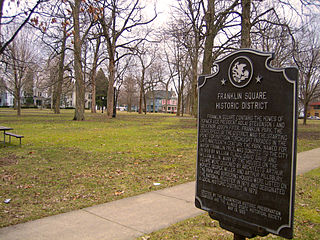
Franklin Square, or Franklin Park is located in Bloomington, Illinois, McLean County. Listed on the National Register of Historic Places, Franklin Square contains the homes of former Vice President Adlai Stevenson I and former Governor Joseph W. Fifer. In 1979 the square was designated as a local historic district. Located northeast of downtown Bloomington, the square encompasses the 300 and 400 blocks of E. Chestnut and E. Walnut streets and the 900 block of N. Prairie and N. McLean streets.

The Sycamore Historic District is a meandering area encompassing 99 acres (400,000 m2) of the land in and around the downtown of the DeKalb County, Illinois county seat, Sycamore. The area includes historic buildings and a number of historical and Victorian homes. Some significant structures are among those located within the Historic District including the DeKalb County Courthouse and the Sycamore Public Library. The district has been listed on the National Register of Historic Places since May 2, 1978.

The Adolphus W. Brower House, in Sycamore, Illinois, has been listed on the National Register of Historic Places since February 14, 1979. The home is located on Illinois Route 64 as it passes through the DeKalb County seat of Sycamore as DeKalb Avenue. The Italianate structure, constructed of stone and asphalt, was erected in 1876 by Sycamore merchant Adolphus W. Brower. It is also known as the George F. Beasley House.
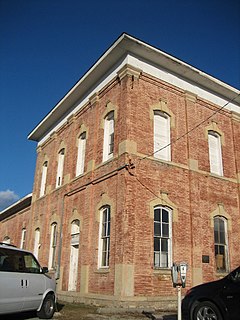
The Chicago and Northwestern Depot is a historic railway station located at the northeast corner of Sacramento and DeKalb Streets in Sycamore, Illinois. The station was built in 1865 to serve as Sycamore's main railway station. While Sycamore was bypassed by the Chicago and Northwestern Railway (C&NW) in the early 1850s, several community leaders developed and built the Sycamore, Cortland, and Chicago Railway to link Sycamore to the C&NW at Cortland. The original line, which opened in 1855, lacked an engine and pulled railcars by mule; as the railway became more successful, it was able to purchase an engine and build the station in Sycamore. The station has an Italianate design which resembles contemporary DeKalb architecture but is noticeably different from the standardized depots built elsewhere in the C&NW system. The branch and station were acquired by the C&NW in 1883.
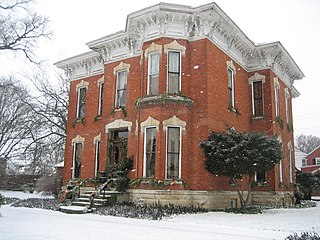
The William H. Holcomb House, also known by Carl Vandre House, is located in the Ogle County, Illinois city of Rochelle. An elegant Italianate structure, the Holcomb House has been listed on the National Register of Historic Places since 1973.

The Chauncey Ellwood House is a 19th-century Italianate residence in the DeKalb County, Illinois city of Sycamore. It is a contributing property to the Sycamore Historic District; added to the National Register of Historic Places in 1978. The house is in the 800 block of Somonauk Street. The Esther Mae Nesbitt House, next door, was once the carriage house for the home.

The Carlos Lattin House was built by Sycamore, Illinois' first permanent settler, Carlos Lattin. It lies within the boundaries of the Sycamore Historic District and is listed as one of the contributing structures in the district. The Sycamore Historic District was added to the National Register of Historic Places in 1978.
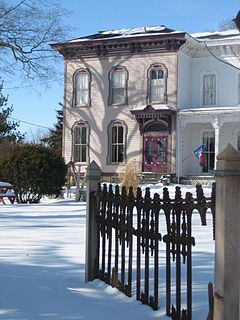
The houses in the Sycamore Historic District, in Sycamore, Illinois, United States, cross a variety of architectural styles and span from the 1830s to the early 20th century. There are 187 contributing properties within the historic district, 75% of the districts buildings. Many of the homes are associated with early Sycamore residents, usually prominent business leaders or politicians. Houses within the district are known by, either their street address or by a name associated with a prominent owner or builder. For most of the houses, the latter is true.

As of 2007 there are five church buildings in the Sycamore Historic District, located in Sycamore, Illinois, United States which are listed as contributing properties to the district. The Sycamore Historic District was added to the U.S. National Register of Historic Places on May 2, 1978. When it was nominated to join the National Register there were seven church buildings within the district. One of those included is a residential structure that was utilized as a church when it was first constructed; the Arthur Stark House was once home to the Sycamore Universalist Church congregation. In the time since its listing, two churches have been destroyed or demolished. The Evangelical Church of St. John was destroyed by fire in 2004 and the United Methodist Church in Sycamore is no longer extant, replaced by a modern office building.

The commercial buildings in the Sycamore Historic District, located in Sycamore, Illinois, United States are mostly located in and around the city's downtown. The largest concentration of commercial contributing properties to the historic district are found along Illinois Route 64 as it passes through Sycamore. They include several buildings known as "blocks" which can consist of more than one adjacent and attached structure, as is the case with the Waterman Block, one of the Sycamore commercial buildings.
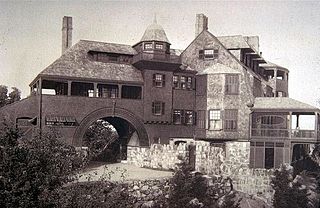
The shingle style is an American architectural style made popular by the rise of the New England school of architecture, which eschewed the highly ornamented patterns of the Eastlake style in Queen Anne architecture. In the shingle style, English influence was combined with the renewed interest in Colonial American architecture which followed the 1876 celebration of the Centennial. The plain, shingled surfaces of colonial buildings were adopted, and their massing emulated.

The Andrew J. O'Conor III House, also referred to as "Riverbend" and "Buena Vista," is a historic home in the city of Ottawa, Illinois, United States. The structure that exists today was originally constructed in 1848 and underwent major remodeling in 1922. The house was added to the U.S. National Register of Historic Places in 1993.

The William H. Van Epps House is a historic house in Dixon, Illinois. It is an example of Italianate architecture. and was constructed around 1855. The Van Epps House was added to the U.S. National Register of Historic Places in 1982.
Marsh House may refer to:
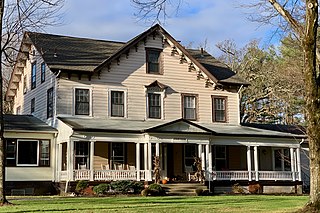
Schooley's Mountain Historic District is a historic district along Schooley's Mountain, Pleasant Grove, and Flocktown Roads, and Heath Lane in the Schooley's Mountain section of Washington Township, Morris County, New Jersey. It was added to the National Register of Historic Places on June 14, 1991 for its significance in architecture, entertainment/recreation, and health/medicine. The district includes 71 contributing buildings, such as the Oak Cottage, site of schoolhouse No. 5, Schooley's Mountain Store, the William W. Marsh House, Christadelphian Bible Camp, the former Heath House Hotel, former Forest Grove Hydropathic Institute, Mine Hill Farm, the Marsh Mine and several private residences and commercial buildings.

The Joliet East Side Historic District is a set of 290 buildings in Joliet, Illinois. Of these 290 buildings, 281 contribute to the historical integrity of the area. Joliet was founded in 1831, deemed an ideal place for a settlement to reap the local natural resources. Most importantly, large beds of limestone provided a strong economic incentive to develop the area. Several important structures were constructed with Joliet limestone, including the Old State Capitol and Chicago Water Tower. Joliet incorporated in 1852 and prospered due to its location on the Illinois and Michigan Canal.

The Lewis Steward House is a historic residence in Plano, Illinois. It was the home of Lewis Steward, a prominent early settler to Kendall County who co-founded Marsh, Steward & Company, ran for the governorship of Illinois, and was elected to the United States House of Representatives.

William Wallace Marsh was a Canadian American inventor and businessman who co-founded Marsh, Steward & Company with his brother Charles. Born in Ontario, Canada, Marsh developed an early harvester prototype on the family farm in DeKalb County, Illinois, United States. With help from businessman Lewis Steward, Marsh, Steward & Company became an early leader in harvester production. The company later merged with others to form International Harvester. Marsh lived in Sycamore, Illinois from 1873 until his death, serving as a longtime alderman.



















